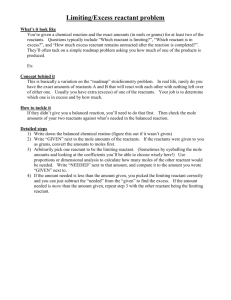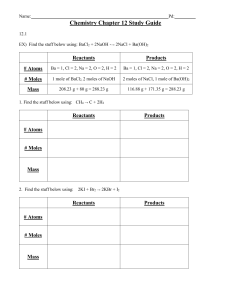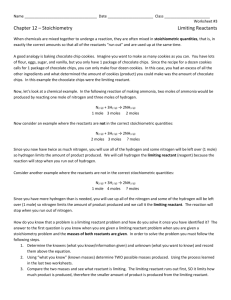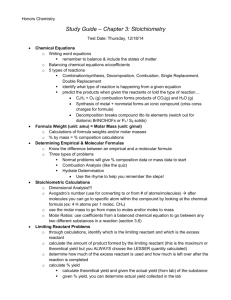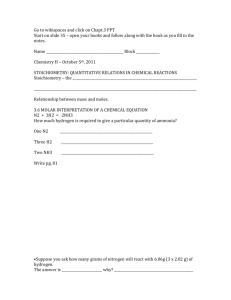Limiting & Excess Reagents - Norbraten
advertisement
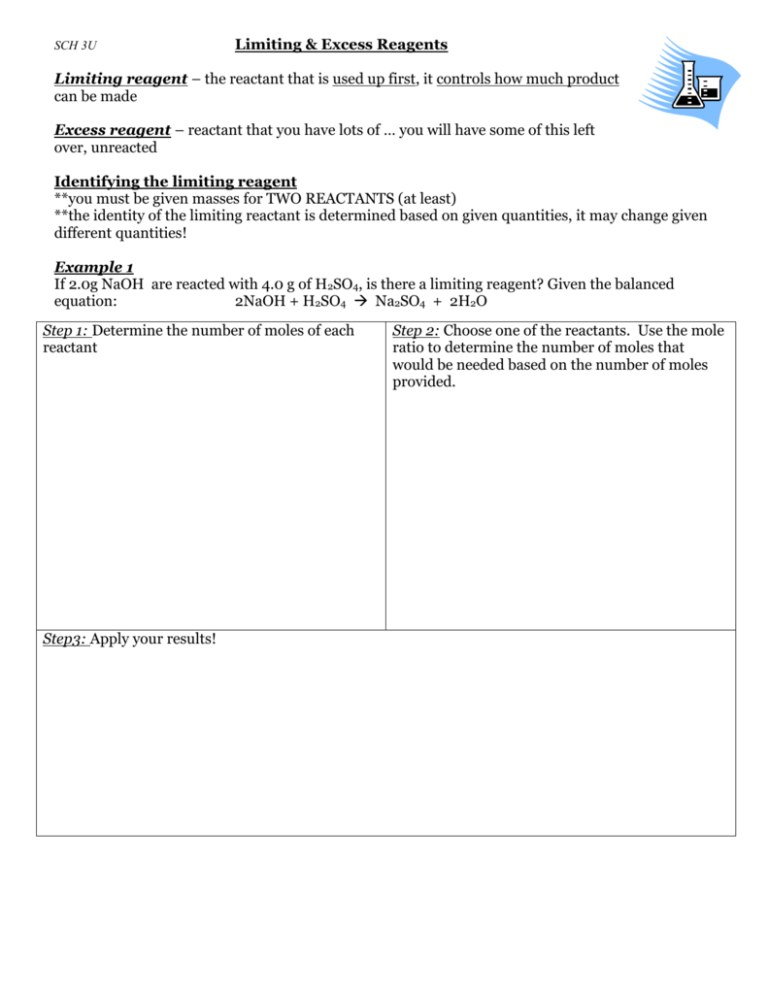
SCH 3U Limiting & Excess Reagents Limiting reagent – the reactant that is used up first, it controls how much product can be made Excess reagent – reactant that you have lots of … you will have some of this left over, unreacted Identifying the limiting reagent **you must be given masses for TWO REACTANTS (at least) **the identity of the limiting reactant is determined based on given quantities, it may change given different quantities! Example 1 If 2.0g NaOH are reacted with 4.0 g of H2SO4, is there a limiting reagent? Given the balanced equation: 2NaOH + H2SO4 Na2SO4 + 2H2O Step 1: Determine the number of moles of each reactant Step3: Apply your results! Step 2: Choose one of the reactants. Use the mole ratio to determine the number of moles that would be needed based on the number of moles provided. Example 2 If 20.0g of NaOH are reacted with 14.5g of H2SO4, is there a limiting reagent? (use the same equation as example 1) Step 1: Determine the number of moles of each Step 2: Choose one of the reactants. Use the mole reactant ratio to determine the number of moles that would be needed based on the number of moles provided. Step3: Apply your results…name the limiting reagent (if applicable) Applying limiting reagents Why is it important to know which reactant is the limiting reactant? The limiting reagent determines the amount of product formed. Given masses of more than one reactant, you must use the limiting reagent to determine the amount of product formed. (a more complicated version of a massmass question!) Example How much H2SO4 can be prepared from 50.0g of SO2, 15.0g of O2 and an unlimited quantity of water? Given the balanced equation: 2SO2 + O2 + 2H20 2 H2SO4 Step 1: Determine the number of moles of each reactant Step 2: Choose one of the reactants. Use the mole ratio to determine the number of moles that would be needed based on the number of moles provided. Step 3: Apply your results…name the limiting reagent (if applicable) Step 4: Use the number of moles of the LIMITING REAGENT to determine the number of moles of product produced. Step 5: Convert moles of product to mass of product. Practice!!! 1. Consider the reaction : I2O5(g) + 5 CO(g) 5 CO2(g) + I2(g) If 80.0 grams of iodine(V) oxide, I2O5, reacts with 28.0 grams of carbon monoxide, CO. determine the mass of iodine I2, which could be produced? 2. How many grams of Al2S3 are formed when 5.00 grams of Al is heated with 10.0 grams of S? 3. When MoO3 and Zn are heated together they react 3 Zn(s) + 2 MoO3(s) ----------> Mo2O3(s) + 3 ZnO(s) What mass of ZnO is formed when 20.0 grams of MoO3 is reacted with 10.0 grams of Zn? 4. Zinc and sulphur react to form zinc sulphide according to the equation. Zn + S ---------> ZnS If 25.0 g of zinc and 30.0 g of sulphur are mixed, a) Which chemical is the limiting reactant? b) How many grams of ZnS will be formed? c) How many grams of the excess reactant will remain after the reaction is over? 5. Silver nitrate, AgNO3, reacts with ferric chloride, FeCl3, to give silver chloride, AgCl, and ferric nitrate, Fe(NO3)3. In a particular experiment, it was planned to mix a solution containing 25.0 g of AgNO3 with another solution containing 45.0 grams of FeCl3. a) Write the chemical equation for the reaction. b) Which reactant is the limiting reactant? c) What is the maximum number of moles of AgCl that could be obtained from this mixture? d) What is the maximum number of grams of AgCl that could be obtained? 6. Aluminum dissolves in an aqueous solution of NaOH according to the following reaction: 2 NaOH + 2 Al + 2 H2O -----> 2 NaAlO2 + 3 H2 If 84.1 g of NaOH and 51.0 g of Al react: i) Which is the limiting reagent? ii) How much of the other reagent remains? iii) What mass of hydrogen is produced? 7. Magnesium metal reacts quantitatively with oxygen to give magnesium oxide, MgO. If 5.00 g of Mg and 5.00 g of O2 are allowed to react, what weight of MgO is formed, and what weight of which reactant is left in excess? 8. The reaction of methane and water is one way to prepare hydrogen: CH4(g) + H2O(g) CO(g) + 3 H2(g) [Molar masses: 16.04 18.02 28.01 2.02] If you begin with 995 g of CH4 and 2510 g of water, what is the maximum possible yield of H2? 9. Disulfur dichloride, S2Cl2, is used to vulcanize rubber. It can be made by treating molten sulfur with gaseous chlorine: S8(l) + 4 Cl2(g) 4 S2Cl2(l) [Molar masses: 256.6 70.91 135.0] Starting with a mixture of 32.0 g of sulfur and 71.0 g of Cl2, which is the limiting reactant? What mass of S2Cl2 (in grams) can be produced? What mass of the excess reactant remains when the limiting reactant is consumed? 10. Aspirin (C9H8O4) is produced by the reaction of salicylic acid (C7H6O3) and acetic anhydride (C4H6O3) (page 163). C7H6O3(s) + C4H6O3(l) C9H8O4(s) + CH3CO2H(aq) [Molar masses: 138.1 102.1 180.1 60.05] If you mix 100. g of each of the reactants, what is the maximum mass of aspirin that can be obtained?


